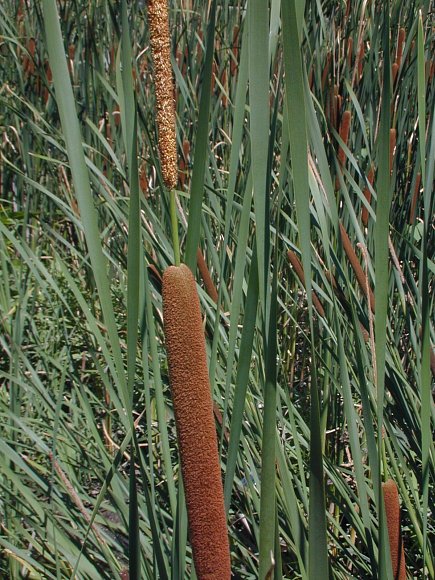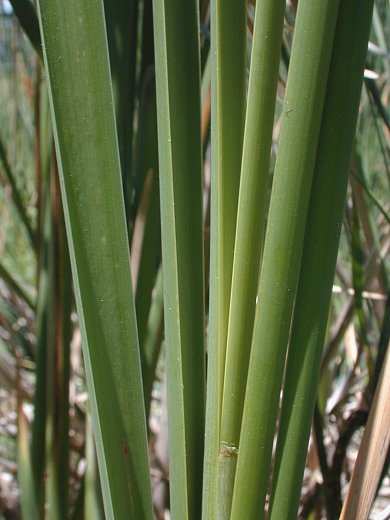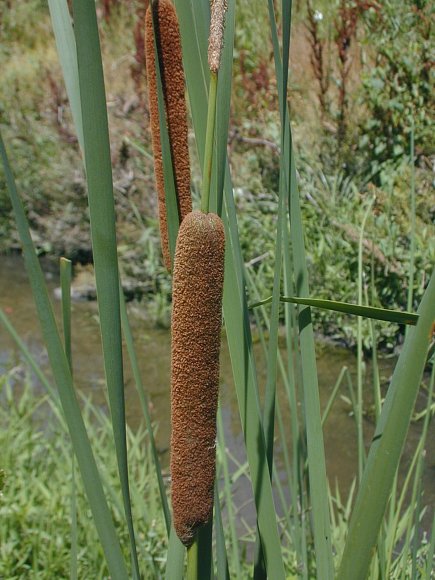Description: This perennial plant is 3-7' tall and unbranched, consisting of a flowering stalk and 4 or more leaves. The flowering stalk is light green to green, glabrous, stiff, and round in cross-section (terete). The leaves are 1½–6' long and up to ½" across. They are green, glabrous, linear, and rather stiff. Relative to the flowering stalk, the leaves are ascending to slightly spreading; the originate from the base of the plant. The inner side of each leaf is flat to slightly concave, while the outer side is convex (plano-convex). Leaf venation is parallel. The base of each leaf is wrapped in a sheath. The stalk terminates in a spike of pistillate flowers and a spike of staminate flowers; the staminate spike is above the pistillate spike and they are separated from each other by at least ½" (usually a few inches). The staminate spike is narrowly cylindrical and densely packed with staminate flowers and abundant hairs; each staminate spike is up to 8" long and ½" across. Each staminate flower bears a single grain of pollen.

The pistillate
spike is cylindrical and densely packed with
pistillate flowers and abundant hairs; each pistillate spike is up to
12" long and ¾" across. Each fertile pistillate flower has a stipe that
is less than 1 mm. long and its bears a single ovary with a slender
style. There are also infertile pistillate flowers that lack ovaries.
The staminate spike is light yellow to light brown, while the mature
pistillate spike is brown or reddish brown. The staminate spike quickly
withers away after shedding its pollen, while the pistillate spike
persists into the fall. The blooming period occurs from early
to mid-summer. Cross-pollination is by wind. Fertile pistillate flowers
are
replaced by achenes (one achene per flower). The root system consists
of rhizomatous rootstocks and fibrous roots. Clonal colonies are
often formed.
Cultivation: The
preference is full sun, wet conditions, and muddy soil. Narrow-Leaved
Cattail is an emergent aquatic that tolerates water up to 1' deep.
Drought is tolerated if the soil remains moist. This plant can spread
aggressively in suitable habitats.

Range &
Habitat:
The native Narrow-Leaved Cattail is a common plant in most areas of
Illinois; it
is less common in southern and NW Illinois (see Distribution
Map).
However, official records
undoubtedly underestimate the distribution of this plant within the
state. In addition to North America, Narrow-Leaved Cattail occurs in
South America, Eurasia, and Africa. At one time, this plant was
relatively uncommon in Illinois, but it has become increasingly common.
In some areas, Narrow-Leaved Cattail is even more common than Typha
latifolia (Common Cattail). Habitats include
marshes, edges of ponds and rivers, and ditches. Narrow-Leaved Cattail
is often the dominant plant in a wetland area; sometimes it is
codominant with Common Cattail. It tolerates severe degradation of
wetlands and is sometimes the last wetland species to survive. It also
occurs in less disturbed wetlands, where it may be invasive and
displace other plant species.
Faunal Associations:
The caterpillars of various moths feed on cattails (including the
leaves, stalks, flowers, and developing achenes). These species include
Simyra insularis (Henry's Marsh Moth), Limnaecia
phragmitella (Shy Cosmet), Dicymolomia julianalis
(Pyralid Moth sp.), Bellura obliqua (Cattail Borer
Moth), and other Bellura spp. Other insects that
feed on cattails include Sphenophorus
australis (Cattail Billbug), the seed bugs Cymus angustatus
and Kleidocerys resedae,
and the aphid Rhopalosiphum
enigmae. The starchy rootstocks are an important source of
food for muskrats. To a lesser extent, the Canada Goose and other geese
feed on the rootstocks. Dense stands of cattails provide cover for many
species of wetland animals, and their leaves provide nesting material
for some species of wetland birds. These wetland birds include the
Marsh Wren, Yellow-Headed Blackbird, Red-Winged Blackbird, Common
Moorhen, American Coot, various rails, and bitterns.

Photographic
Location:
A drainage ditch in Savoy, Illinois.
Comments:
Many members of the public will recognize this species as a cattail;
however, they may be less aware of the fact that there are two cattail
species in Illinois. Because the distributions of Narrow-Leaved Cattail
and Typha latifolia (Common Cattail) overlap and
they sometimes hybridize, it can be difficult to identify a specimen
plant in the wild. The hybrid plants are referred to as Typha
× glauca (Hybrid Cattail) and it has characteristics of both
parents. Generally, Narrow-Leaved Cattail has narrow green leaves (up
to ½" across) and pistillate spikes that are up to ¾" across and 1'
long. Its pistillate spike and staminate spike are separated from each
other by at least ½" (usually a few inches). In contrast, Common
Cattail has green to greyish blue leaves that often exceed ½" across
and its pistillate spikes are larger in size (often exceeding ¾" across
and 1' in length). The pistillate and staminate spikes of Common
Cattail are adjacent to each other, or they are separated by a distance
of ½" or less.